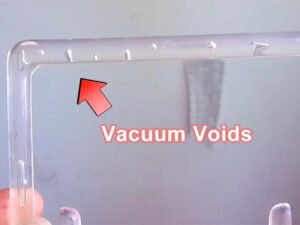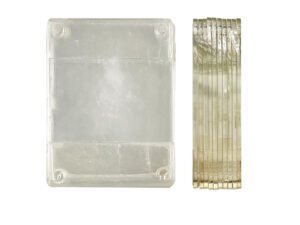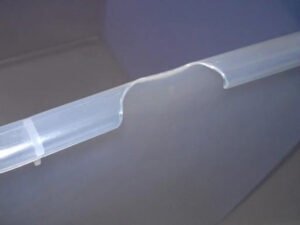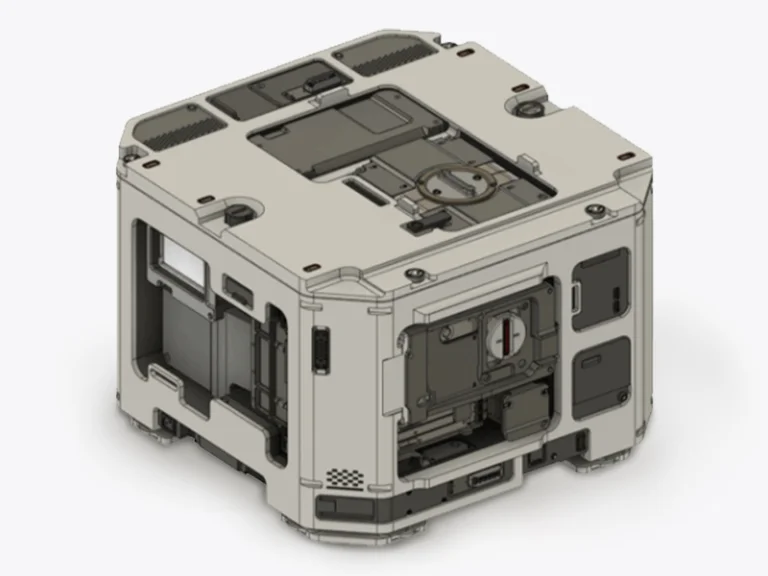Clear plastic injection molding is a specialized process used to create high-quality, transparent plastic parts that are essential in various industries such as automotive, medical devices, and consumer goods. This article explores the common challenges faced during the molding of clear plastics, including streaking, bubbles, and discoloration, and offers practical solutions to overcome these issues. By optimizing key factors such as material quality, mold design, and injection parameters, manufacturers can achieve superior clarity and precision in their molded parts, meeting the growing demand for transparent solutions in modern manufacturing.
What is Clear Plastic Injection Molding?
Clear plastic injection molding is a specialized manufacturing process designed to produce high-quality, transparent parts. This method involves injecting molten clear plastic materials, such as polycarbonate or acrylic, into a precision-engineered mold. The process is highly favored for creating products that demand optical clarity, structural integrity, and aesthetic appeal. Used across various industries, including automotive, medical, and consumer electronics, clear injection molding delivers transparent parts with consistent dimensions and minimal imperfections, ensuring both functionality and visual excellence.
Clear Plastic Molding Material Choices: A Comparative Analysis
Clear plastic molding involves selecting materials that not only provide aesthetic appeal but also meet specific functional requirements. The most commonly used materials in this field include Acrylic (PMMA), Polycarbonate (PC), High-Density Polyethylene (HDPE), and others. Each material has unique properties that make it suitable for different applications.
1. Acrylic (PMMA)
- Optical Clarity: Acrylic is renowned for its excellent optical light transmittance (about 93%) and UV resistance, making it ideal for applications requiring transparency, such as lenses and displays.
- Properties: It is lightweight, non-toxic, and can be polished to maintain clarity. However, it is somewhat brittle compared to other plastics.
- Applications: Commonly used in outdoor signage, lighting fixtures, and protective barriers.
2. Polycarbonate (PC)
- Impact Resistance: Polycarbonate offers remarkable strength and impact resistance, making it suitable for safety applications like goggles and shields.
- Optical Properties: With a light transmittance of 88-90%, PC maintains good clarity while being more durable than acrylic.
- Applications: Used in automotive components, eyewear, and electronic housings.
3. High-Density Polyethylene (HDPE)
- Durability: HDPE is known for its toughness and chemical resistance, with a light transmittance of about 80%. It is also non-toxic, making it safe for food-related applications.
- Flexibility: While not as clear as acrylic or polycarbonate, HDPE is cost-effective and widely used in containers and packaging.
- Applications: Commonly found in bottles, toys, and industrial products.
4. Polyetherimide (PEI)
- Heat Resistance: PEI is known for its excellent heat resistance and mechanical properties, suitable for high-temperature applications.
- Light Transmittance: It has a lower light transmittance of around 82%, making it less ideal for optical applications compared to acrylic or polycarbonate.
- Applications: Often used in aerospace and medical devices.
5. Polypropylene (PP)
- Chemical Resistance: PP offers good flexibility and chemical resistance with a light transmittance of approximately 90%.
- Applications: Commonly used in textiles, packaging, and consumer goods.
6. Optical Liquid Silicone Rubber (OLSR)
- Innovative Material: OLSR stands out due to its high light transmission (94%) and non-yellowing characteristics.
- Applications: Excellent for lighting applications and outdoor products where clarity over time is essential.
Mold and Product Design Tips for Clear Plastic Injection Molding
Achieving high optical clarity in clear injection molding starts with meticulous design choices. Here are some design tips to considerations for clear plastic injection molding.
- Ensure Uniform Wall Thickness: Prevent optical distortion and warping by maintaining consistent thickness throughout the part.
- Avoid Sharp Corners: Rounded corners and smooth transitions help prevent air traps and stress accumulation.
- Incorporate Draft Angles: Aid in part release from the mold, reducing the chance of surface imperfections.
- Surface Finish Quality: Use high-quality mold polishing and ensure mold cleanliness to avoid surface defects.
- Manage Cooling Rate: Slow cooling reduces cloudiness and internal stresses, ensuring better clarity.
- Dry Materials Before Injection: Prevent moisture-related issues like fogginess and bubbles.
The Injection Molding Process for Transparent Plastics
The injection molding process for transparent plastics is a sophisticated method that requires precision and attention to detail to achieve high clarity in injection molded parts. This process is essential for producing clear plastic components used in various applications, such as automotive parts, consumer goods, and optical devices.
Step-by-Step Explanation of the Injection Molding Process
1. Material Preparation
- Drying: Clear plastic pellets or resins must be thoroughly dried to remove moisture before processing. This is crucial as any moisture can lead to defects like bubbles or cracks during molding.
- Feeding: Dried pellets are fed into the injection molding machine from a dry hopper, ensuring they remain free from contaminants.
2. Injection Unit
The dried material is heated in the injection unit until it reaches a molten state. The temperature must be carefully controlled to ensure optimal flow and prevent degradation of the transparent material.
3. Injection into the Mold
The molten plastic is injected into the mold cavity under high pressure. This step requires precise control of injection speed and pressure to fill the mold completely without creating internal stresses that could lead to deformation or cracking.
4. Cooling
After injection, the mold is cooled to solidify the plastic. The cooling rate must be managed to avoid warping and ensure uniform thickness, which is critical for maintaining clarity in injection molding.
5. Ejection
Once cooled, the molded part is ejected from the mold. Care must be taken during this step to prevent scratching or damaging the surface of clear injection molded parts.
6. Finishing
Post-processing may include trimming, polishing, or additional treatments to enhance clarity and surface quality. This step is vital for achieving high transparency in the final product.
Importance of Precise Temperature Control and Molding Conditions
Precise temperature control during the transparent molding process is vital for several reasons:
Surface Quality: Maintaining an optimal mold temperature ensures that the surface of the molded parts remains free from defects such as streaks, haze, or discoloration, which are particularly noticeable in transparent materials.
Flow Characteristics: The temperature affects the viscosity of the molten plastic; higher temperatures can improve flow but may increase cycle times if not managed properly.
Dimensional Stability: Proper temperature control minimizes shrinkage and warpage during cooling, which is crucial for maintaining clarity and dimensional accuracy in clear injection molded parts.
How Mold Design and Equipment Affect Final Product Transparency?
The design of molds and choice of equipment play critical roles in achieving transparency in injection molded products:
Mold Surface Finish: High-quality mold surfaces are essential for producing clear parts. Any imperfections on the mold can translate directly to visible defects on the final product.
Material Selection: The choice of transparent materials (like acrylic or polycarbonate) impacts clarity; each material has unique properties that affect light transmission and surface finish.
Injection Molding Equipment: Advanced machines with precise control over injection parameters are necessary for producing high-quality transparent components. Machines must be capable of handling specific materials while maintaining consistent temperatures and pressures throughout the process.
In conclusion, successful transparent plastic injection molding hinges on meticulous attention to detail throughout every stage—from material preparation to mold design and temperature control—ensuring that the final product meets stringent clarity requirements essential for its intended application.
Common Challenges and Solutions of Clear Injection Molding
Clear injection molding, used to produce transparent plastic parts, faces unique challenges such as streaking, bubbles, and discoloration. These issues can compromise the appearance of molded parts, especially when clarity is a priority. Here are common problems and their solutions:
1. Streaking and Surface Imperfections
Streaking occurs when visible lines appear on the surface, often due to uneven cooling or material contamination. This is particularly noticeable in clear injection molded parts.
Solution: Ensure uniform cooling with well-designed systems, and use pure materials to avoid contamination. This helps achieve a smooth, clear surface.

2. Bubbles and Air Traps
Air bubbles trapped in the material can distort transparency, creating unwanted visible marks.
Solution: Control injection speed and pressure carefully, and use vacuum-assisted molding to remove trapped air. Moisture control is also key to preventing steam-induced bubbles.

3. Discoloration and Yellowing
Excessive heat, improper material handling, or low-quality resins can cause yellowing, reducing the clarity of the molded parts.
Solution: Keep processing temperatures within the optimal range, use UV-resistant resins, and ensure proper material storage to avoid degradation and discoloration.

4. Poor Flow and Fill Issues
Inconsistent material flow can lead to defects such as short shots or weld lines, impacting the clarity of the part.
Solution: Optimize mold and gate design, adjust injection pressure and speed, and monitor the resin’s temperature to ensure consistent filling and smooth flow.

Quality Control Measures for Transparent Injection Molding
To ensure high-quality, transparent molded parts, consider the following quality control measures:
- Material Quality: Use high-quality, contaminant-free resins designed for transparency.
- Mold Design: Implement optimized cooling and venting channels to reduce defects.
- Injection Parameters: Carefully control injection speed, pressure, and temperature to maintain clarity.
- Inspection: Regular visual checks and non-destructive testing can help spot defects early.
Conclusion
Clear plastic injection molding plays a vital role in producing transparent plastic parts used in industries like automotive, medical devices, and consumer goods. As demand for high-quality, transparent parts continues to grow, optimizing the transparent molding process is crucial. By using the right materials, controlling injection speeds, and ensuring uniform cooling, manufacturers can produce clear injection molded parts with superior clarity and minimal defects.




